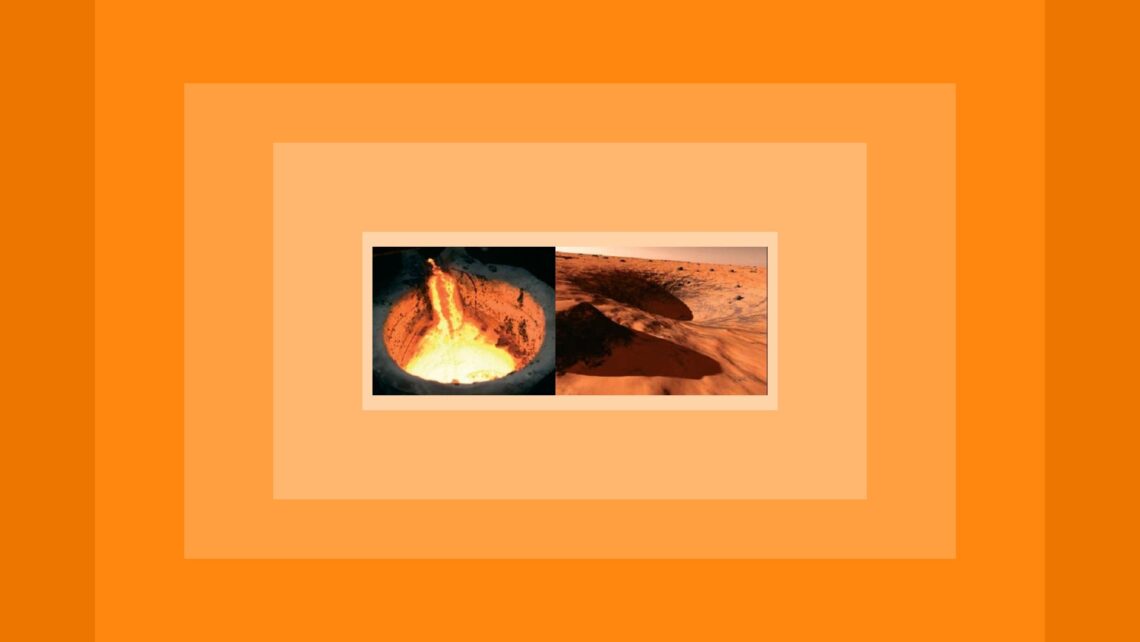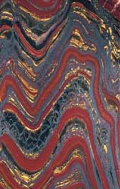Iron – The Element
Warrior archetype
Though the world entered the new millennium with bright hopes for a new and better future, possibly even an idyllic, peaceful Golden Age, strife and conflict are escalating. Never a day goes by without news of some act of savagery and destruction. The forces of disorder are proliferating, seeking to undermine stability and establish anarchy. Today violence has never been more indiscriminate. We are yet in the grip of the Iron Age, the gods of war remain insatiable and the shadow-warrior moves in our midst.
An ambivalent metal
It has been the destiny of iron more than any other metal to serve the forces of war and destruction, yet, like all the metals, it possesses a profound ambivalence. The intuitive response of ancient civilisations to this powerful substance emphasises its symbolic ambiguity. The Aztecs prized meteoric iron as a celestial and sacred metal falling from heaven as a gift from the gods, whilst the Egyptians equated it with the bones of Set, a destructive, diabolical divinity, worshipped by some, execrated by others, but universally feared. He embodied primeval power perverted to wicked ends and was perceived as a negative force in the cosmic and moral conflict between good and evil.
Iron-copper polarity
Ancient Chinese tradition sees iron and copper as polar opposites, iron being base, yang, masculine, a fire element and related to the colour red, while copper is noble, yin, feminine, a water element and related to the colour black. Other cosmologies perceived the same contention: hard, crude, rigid, dark iron when contrasted with soft, subtle, warm, shining copper, appearing as the dark or shadow aspect – “lord of darkness and night” – the perfidious purveyor of carnage and death, while copper represented brightness, light and love. In modern myth, Tolkien portrays a corresponding distinction between the loathsome, bestial, warlike orcs and the exquisite, gentle, spiritual elves, and likewise between Gandalf, the noble warrior wizard and Saruman, the black-hearted, fallen wizard. Darth Vader of Sky Wars, masked in steel, is the quintessential dark warrior, who, like Saruman, is a manifestation of malicious and misguided power. His laboured breathing is in keeping with the marked asthmatic tendency of Ferrum (invariably worse at midnight). The “Set-complex” of virtue corrupted, demonstrated by these two mythical beings, is symbolised in the inexorable corrosion and disintegration of iron over time to a ravaged travesty of its pristine form.
A vital metal
As the molten globe of the newly created Earth began to cool, the closely related elements, iron and nickel, gravitated to form the core of the planet. Here, their magnetic, ethereal energies radiate the masculine and feminine forces of Gaia. Iron is essential to the “life” of the planet. It is also vital to the life processes of all plants and animals. It is the core atom of haemoglobin, the respiratory pigment of mammals. In the human being it therefore holds centrestage, built into the blood, which together with the heart, expresses the very pulse and passion of the ego. Hence, Ferrum must be regarded as one of the most fundamental archetypes in the human psyche and its relationship to haemoglobin, blood and the fire of the ego confirms the ancient knowledge of its kinship with the colour red.
Red and the body
Physically, red signifies fever and this is common to the acute Ferrum state, but even more so for Ferrum’s “tissue salt”, Ferrum phosphoricum, a remedy as important as Aconite and Belladonna in treating fever. Organically, red indicates the blood, heart, circulation and blood vessels, and organs that are particularly rich in blood – the thyroid, lungs, liver, spleen, reproductive organs and muscles. Organ relationships, when pronounced, often provide insight into nature and temperament. Ferrum is above all splenic, sanguine and choleric.
Artwork showing an impact crater on a Martian landscape – the rocks’ orange colour is due to a high content of iron oxides
Red and the spleen
The spleen symbolises anger, indignation, irascibility and especially rancour and bitter resentment. A Ferrum knows well how to nurse a grudge and “vent his spleen”. True to the warrior code, the cause of such grievance is invariably a betrayal of trust, breach of loyalty or a slight to reputation. The lower Ferrum is incensed by the least opposition or challenge to his authority. He is always right and cannot tolerate contradiction or criticism which he can never forgive; the offender will either be ostracised or become the victim of reprisal. Their anger is inordinate – it is wrath, rage and fury – when the “blood is up” they “see red”!
Red and the blood
In the sanguine disposition, the blood runs fast and furious, accompanied by sparkling eyes, a buoyant, jaunty air and flushed countenance. Their manner is assured, confident and optimistic and if put to the test they are found indomitable and courageous. True to the medieval meaning of sanguine, if called upon, they are willing (sometimes eager) to shed blood, even their own. How could it be otherwise with iron, the element of blood and the implement of war? They are excitable, warm, romantic, ardent and animated, given to passions and enthusiasms. They believe, love and hate with passion. Without focus they decline into boredom.
Red and the lungs
Ferrum has a particular affinity for the lungs and has often been used successfully in the treatment of asthma, particularly when exercise-induced, and tuberculosis, especially the incipient stage in young people. This relationship to TB imparts to the archetype a restless, romantic, adventurous spirit that loves excitement, stimulation and challenge; an idealistic, often altruistic, need to bring about change either by reformation or revolution; and a sense of the imminence of death.
Red and the root chakra
Red and Ferrum are principally related to the first or root chakra, a dense, swirling vortex of vital-force energy situated at the base of the pelvis. Physically and energetically it is our very foundation, providing the stability and security upon which our vitality, health and survival depend. The Ferrum martial arts exponent aligns his stance with this pyramid of power, giving him poise, balance and the potential for explosive, yet controlled, action or reaction. He taps into the male and female vitality of the earth core with which he resonates, and is thus imbued with the panther-like strength and grace of the warrior-dancer.
Security and survival
The consciousness of the root chakra is at the instinctual level, focused on survival, encompassing the primal, animal instincts of sex and aggression. Threat to survival stimulates the primitive, reptilian brain and the amygdala (memory brain), which in turn triggers the conscious brain (the cortex), enabling the body to react instantaneously with an adrenaline response: fight or flight. In the typical Ferrum archetype, these pathways possess a primed, innate tension, like a tightly drawn bow; they are ever alert, watchful and wary. Here is a man who sleeps with one eye open and watches his back. In the presence of such a hyper-vigilant state, usually due to traumatic experiences in the past life of the individual, his family or his people, a perceived offence or insult can precipitate an excessive and inappropriate reptilian-amygdala response that swamps and overrides the rational brain, leading to an emotional crisis that can be violent and out of all proportion to the event. Road rage and wife-beating are of this order. In such a taut individual, abuse of alcohol may lead to tragedy.
Life is war
To Ferrum, life is a state of war, siege, attack and counter-attack. There is always an enemy; the world and humanity are inherently hostile. This harks back to a time when our lives were under constant threat and the strength and vigilance of the first chakra were essential to survival. This paranoid outlook may result from a traumatic upbringing in which the young Ferrum is exposed to physical, verbal and emotional abuse. Attempts may have been made to break his spirit by severe beatings, harsh coercion, or being cruelly confined but instead of breaking, his spirit is tempered and hardened like steel. He will become strong, courageous and steadfast, the antithesis of those who abused him, or he will move to the dark side and become the abused abuser, perpetuating a sordid sequence. Ferrum is often the remedy for such a history, but it is even more specific for the treatment of posttraumatic stress disorder, for those who have experienced the horrors of war and witnessed carnage and are suffering the consequences.
The pioneer
The root chakra is also concerned with tribe, tradition, territory, hierarchy, ritual, propagation, nourishment, rest, warmth and shelter, all of which urge humanity towards establishing foundations, villages, farms, cultures and eventually civilisations. Fundamentally, Ferrum is a man of the earth; iron can be fashioned into a sword, but also into a ploughshare. All the ancient war-gods evolved culturally from divinities previously linked to vegetation and agriculture. Ferrum is a pioneer, an explorer and an adventurer. He has a burning desire to discover, to investigate, to research, to probe ever more deeply and to widen his horizons and territory. Infused with the energy of the first chakra he has the zeal, drive, enterprise and energy to build great things from very little, just as the giant oak grows from the tiny acorn. He is a born initiator and strategist and a fine leader of men. He is a pioneer-soldier, therefore also an invader and a conqueror. His acquisitive gaze may extend to territory that belongs to others, even to nature.
Iron and the intellect
Iron relates to the intellect rather than the heart, and its use has paralleled the evolution of human civilisation. The great iron ore deposits of the planet extend in a mighty belt across the temperate zones of the entire northern hemisphere. These areas have been likened to the chest and thorax of the planet, while the tropical and equatorial regions constitute the centre of metabolism. We see here the correspondence between iron, lungs, haemoglobin, oxygenation and intellectualisation. It was in this northern temperate zone that the mind of man reached that level of technological consciousness that iron would be essential for its expression. The iron deposits are present just where they were required, and more curious still, the earth’s great coal deposits are found in the same regions, following the iron belt through the northern continents. Iron and coal provided a combination essential for the fabrication of steel and the industrial revolution. One without the other would not have sufficed.
Banded ironstone – primitive bacteria caused iron to be oxidised and precipitated
Conqueror of nature
Ferrum’s logic is masculine and heavily left cerebral. He represents the modern mind coloured by the bleak Newtonian vision of today’s science. Such a pragmatic intellect is closed to subtle concepts such as homeopathy and despises God as an unscientific delusion. He is militant and needs to attack and crush these fallacies with his scientific fundamentalism. The cosmos of the ancients, filled as it was with purpose and intelligence and driven by the love of God for the benefit of man, is lost to him, and replaced by a merciless, goalless, clockwork machine. With the loss of God comes the loss of nature. He no longer experiences himself as a child nourished at her breast, sheltered and carried. He is an alien warrior in an alien environment, a stranger to the world with which he is at war. With a godless heaven above and a hostile environment below, the scientist Ferrum sets about the conquering of mother earth, overwhelming her and binding her with shackles of iron, putting her to his own use, indifferent to the consequences. This is the paradox of iron: at the core it is the life force of Gaia, but wrested from the earth and forged into the artefacts and weapons of technology it defiles and destroys the planet. The war is witnessed in the desecration of our environment and the fortresses proliferate everywhere: ugly man-made iron and concrete structures spewing forth contamination. The grim, unrepentant warrior standing amidst the devastation is often a Ferrum. In Lord of the Rings, Saruman, the corrupt magician, embodies the soulless scientist who, to his own ends, manipulates life through perverse technology and wages war against the forces of good.
Physical profile
The archetype can often be recognised by their outer appearance, carriage and mannerisms. The features are strong and well-defined, characterised by a square, forceful jaw, a wide brow and a firm, determined mouth. The jaw is often jutting and cleft. The glance is direct from steely eyes. The expression can be dignified, composed, assertive, resolute, hard, intimidating, arrogant, pugnacious, or even cruel, depending on character and circumstance. In youth, they are athletic and muscular, their condition toned by disciplined activity and frequently developed by “pumping iron” in the gym. Their bearing is often erect and military. In middle age they tend to become stiff and corpulent. If balanced, they bear themselves with dignity, have an air of authority and a powerful presence; if overblown, they may swagger and strut, appearing arrogant, overbearing or even pompous.
God of war – Ares
The god of war has two aspects, one negative – the Greek Ares, and the other positive – the Roman Mars. Ares was the least respected and honoured of the Olympians. The Greeks regarded him as the embodiment of the destructive forces of war: a crass, mindless, bloodthirsty warmonger, delighting in bloodshed, slaughter and strife, in contrast to the goddess Athene, who represented the sober tactics and strategy of war, especially when used to defend the community. His sons Deimos (Fear) and Phobos (Panic) attended him. His name is synonymous with “the frenzy of fighting” and “the warrior’s ecstasy”. These appellations link him to Dionysos (Bacchus) and Wotan (Teutonic Lord of Ecstasy), hence to Thuja and Lac caninum respectively. He is the Olympian “actionman”. His modern equivalent is the sportsman for whom winning is everything. His approach is uncompromising; he will do anything to overcome the opposition (enemy); no holds barred. He excels at contact sports in which he can give free rein to his raw, and often bloody, aggression. They are frequently penalised for fouls, against which they offer fierce, incredulous protest, arguing with the referee, swearing, making vulgar gestures and getting into punchups with opponents and spectators. Unfortunately, the aggression that brings them success on the playing field can spill over into their private lives and discredit them. They are often found in the ranks of professional boxers and wrestlers, idolised by their fans for behaviour which in cricket, tennis or athletics would be frowned upon. They are not averse to taking banned substances to boost their performance.
Ares the dancer
Ares was the son of Zeus and Hera, the father and mother figures of the Olympian pantheon. Hera entrusted his early education to the phallic god Priapus, who first instructed him in dancing and then in every manly sport and the skills of a warrior. This sequence is significant as dancing, especially ballet, provides an excellent foundation for any activity that demands great co-ordination, grace and athleticism. In martial arts the basic exercise movements are performed as if executing a solitary dance. The Ares archetype is in his body; his emotions and body are one; he has animal energy and reflexes. Many a Ferrum becomes a professional performer, dancer or acrobat, and is admired for his passion, intensity, athleticism, stamina, interpretation and technique. Muhammad Ali embodied the combined qualities of warrior and dancer.
Ares the lover
Ares was the long-term lover of Aphrodite, the goddess of love and beauty, sexuality and sensuality (Cuprum, the next archetype of this series). Their relationship was open, tempestuous and passionate, punctuated by ruptures and reunions but remained irresistible and insatiable. True to his divine counterpart, Ferrum is capable of loving a woman and yet having sexual adventures on the side. He has a lusty, ardent nature and is essentially amoral. His sexuality is earthy, strong and confident, undaunted by a woman’s beauty or experience. To be the chosen lover of the most desirable and sexually discerning goddess of all indicates that the archetype comes highly recommended. In some, the libido energy is transmuted into artistic creativity.
God of war – Mars
The Romans held Mars in high regard, second only to Jupiter in importance, and revered him as the founding god of Rome and its divine protector. To the youth of today, his equivalent would be Superman, Batman or Spiderman, guardians of the community, the epitome of manly strength, courage and fair play. In sport he could be a man like Lance Armstrong, who fights testicular cancer with secondary tumours in the lungs and brain, and then indomitably presses on to triumph seven times in the Tour de France and promotes fund rais ing for cancer research. The archetype must always be doing and achieving. They are men who must have a challenge. They always want to go further, climb higher, dive deeper, go faster and prove that they are stronger and fitter than the rest. The saying: “when the going gets tough, the tough get going” suits this Ferrum perfectly. They are often rescuers, placing their own lives in jeopardy to save others. They will not desert a companion in distress. These adventurers, although attracted to challenges that are often potentially dangerous, are not reckless. Their watch words are always – preparedness, proficiency and performance. They know there is no margin for error; there may be only one chance. When it comes to their equipment every nut and bolt will be meticulously checked. When they act they do so like the samurai: leaping into battle with the full potential of the ki, vital energy, at their disposal. For Ferrum there is only one way to face the battle of life – frontally, and only one direction to move – forward! The Mars-type Ferrum moves also upwards, achieving pre-eminence in any field of endeavour they undertake. Can one doubt that the Ferrum executive entering the boardroom is a gladiator girding his or her loins for battle? His is the ”iron fist in a velvet glove”; she is the “iron lady”. Though they may be feared, they have earned both respect and loyalty.
High warrior
The peace-loving Ruskin came to the dreadful conclusion that “ … war is the foundation of all the arts … the foundation of all the high virtues and faculties of men … all the great nations were nourished in war and wasted in peace… born in war died in peace.” In Europe and Japan in medieval times, out of the savagery of war blossomed a noble morality. Chivalry became the child of feudalism. In Japan, Bushido became the code of moral principles, which the samurai were required to observe. The high warrior embodies these precepts and in his loftiest form will fight and lay down his life for justice and the rights of others. He is the champion, liberator, rescuer and reformer. Being a warrior at this level is a total way of life driven by a code that is unuttered and unwritten, inscribed only on the tablets of the heart.








